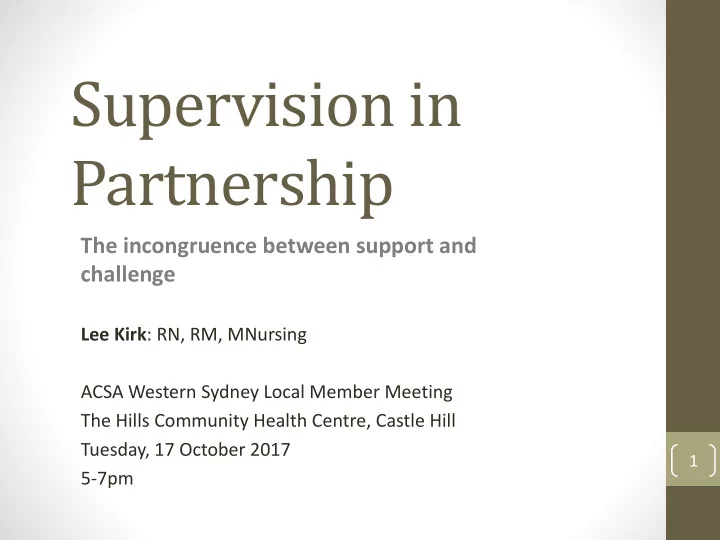

Supervision in Partnership The incongruence between support and challenge Lee Kirk : RN, RM, MNursing ACSA Western Sydney Local Member Meeting The Hills Community Health Centre, Castle Hill Tuesday, 17 October 2017 1 5-7pm
Introduction and background • Brief professional history • Personal, professional, as a supervisee and supervisor • Model of Supervision • How I came to this model • Discuss how the FP Model underpins both supporting (scaffolding) or enabling change (challenging) when explicit agreement is negotiated. 2
Partnership • Partnerships are about ‘giving and receiving’ rather than ‘knowing and telling’ • Supervisor and Supervisee must work closely together, be involved and actively participating if the supervision relationship is to be productive • Some degree of separation is required in the Supervisor, Supervisee relationship such that both bring their different knowledge/resources to a supervision session 3
Partnership as implied by Gibran (1992) ‘And stand together yet not too near together: For the pillars of the temple stand apart, And the oak tree and the cypress grow not in each other’s shadow.’ 4
Family Partnership Supervision Model 5
Personal Construct Theory (Kelly) • Tells us not what to think but rather how to go about understanding what we do think. • A person’s processes are psychologically channelised by the way in which he/she anticipates events. Both supervisor and supervisee personal constructs play their part. All interpersonal communications also 6
Restorative – Formative - Normative • Restorative: Support, empowerment not control. Recognition of stress, the work that enables the practitioner to work with energy and creativity. • Formative: Reflection on experience in practice. Develop professional knowledge and skills • Normative: Quality, accountability, standards, centrality of professional practice. 7
Supervision Contracting • Discuss with supervisee • Sought or forced • Previous experience of supervision • Understanding of model – e.g. The Theory of Constructs, Strengths based. • Supervision agreement is explicit • Confidentiality also explicit • Purposeful nature of the supervision relationship • Agree, explicit understanding of expectations of the supervision relationship 8
Balancing support and enabling change • Examples • Client/patient complaint about supervisee • Supervisee resistant to reflective practice • Expert/Medical model preference by supervisee • Conflict with peers or management • Disciplinary issues 9
Incongruence between support and enabling change if required . • The Supervisory relationship needs to be sound and based on the qualities and skills identified in the Family Partnership Model. • The Supportive role is about empowerment not control, self awareness and self development. • Change and development are concerned with influencing the focus, constructs and practice of supervisees • Challenging is undertaken in a careful, tentative and 10 invitational way in partnership with the supervisee
Skills Enabling Supporting/Scaffolding Change/Challenging • Advanced empathy • Active listening with intellectual and emotional • Use of reflection and attunement summarising • Listening and responding • Explore supervisees empathically constructs • Prompting and exploring to • Enabling change in ideas gain a clear understanding • Negotiation of a way forward • E.g. Problem management 11
Interpersonal Skills of Supervisor • Listen, attend fully, be present and listen for what the situation means to the supervisee • Show Empathy – try to understand what it is like for them. Empathy can be shown even if you disagree with their behaviour. • Summarise what the supervisee has expressed to ensure your understanding and show you are listening. • Share how the session will proceed when a focus or focuses 12 for the session are clear
Tips • Explicit supervisor and supervisee responsibilities • Model the model – discuss the model with the supervisee • Ask rather than tell • A constructive, critical examination of the supervisee’s constructs. • Work together to achieve mutual respect i.e. Unconditional Positive Regard • Use their own words/constructs ( e.g. disputation of conflicting information) • Hone the skills of enabling change (an iron fist in a silk purse) • Never assume that the supervisee is at the same place they were the last time you saw them. • Problem management of identified issues requires explicit 13 exploration of goals, strategies and implementation plans
References • Braun,D,Davis,H. & Mansfield, P. (2006). How Helping Works: Towards Shared Model of Process. London: ParentlinePlus • Ellis,M. Version1.0, Family Partnership Model: Supervision Course Handbook. The Centre for Parent and Child Support: London • NSW Health, HETI Health Education & Training Institute (2013). The Superguide, A Supervision Continuum for Nurses and Midwives • Davis, H., & Day, C. (2010) . Working in Partnership: The Family Partnership Model. London: The Psychological Corporation 14
Recommend
More recommend